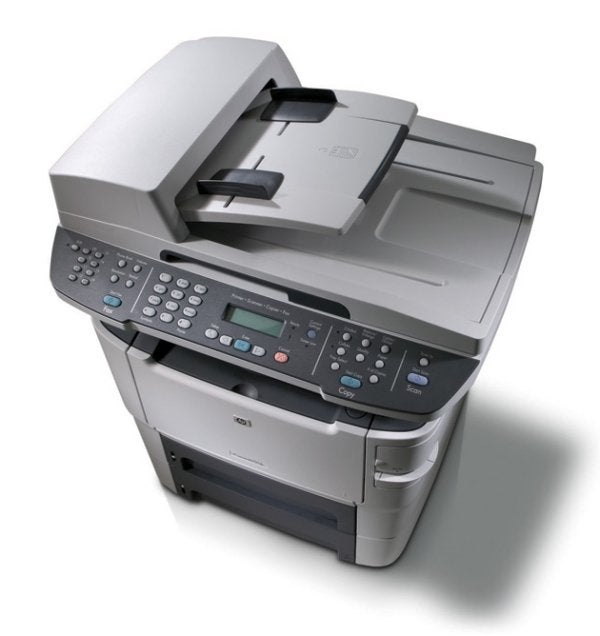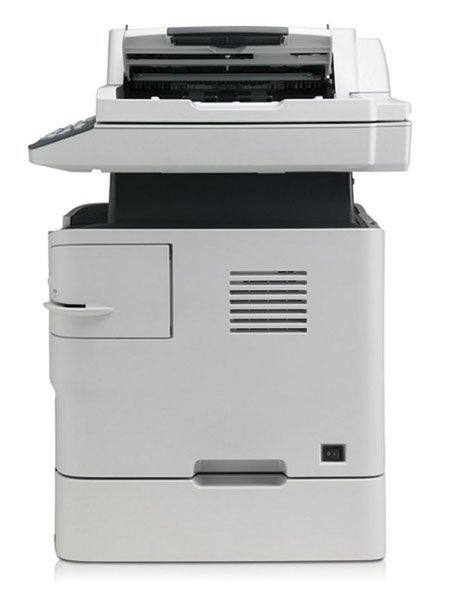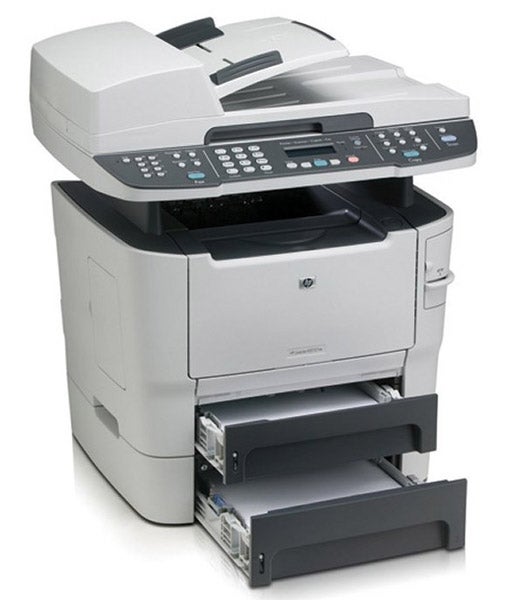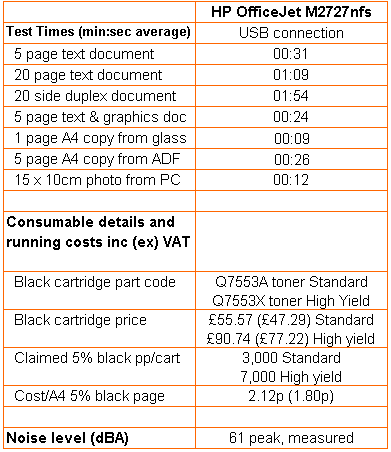HP LaserJet M2727nfs Laser MFP Review
HP LaserJet M2727nfs Laser MFP
This mono Laser MFP from HP appears to deliver everything a busy office would need.

Verdict
Key Specifications
- Review Price: £458.32
What do you need from a mono, laser multifunction device in an office? Good quality print, obviously, and a quick turnaround, but it would also be nice to have built-in duplex printing, a fast scanner that doesn’t take ages to warm up, two paper trays and a multi-purpose feed, probably built-in fax and, hey, what about a stapler to hold documents together? If these are your thoughts, HP has been listening.
There’s nothing too remarkable about the design of the LaserJet M2727nfs, in fact it has a slightly dated look, with the flatbed scanner sitting high above the laser engine on two plastic pillars. The 50-sheet feed tray for the Automatic Document Feeder (ADF) also arcs away high above the lid of the flatbed and the second, 250-sheet paper tray lifts the device still higher, so, if it sits on a desktop, you’ll need to operate it standing up.
The control panel has a pretty standard layout, with 16 preset fax number buttons at the left, together with access to the phone book, resolution selection and redial, as well as a button to start faxes. Next to this is a number pad for phone dialling and in the centre is a 2-line by 16-character, backlit LCD display, with menu navigation buttons in front. To the right of this are copy controls, including tray select, reduction and enlargement and the option of two-sided copying – though the scanner is only single-sided. Finally, at the extreme right, are Scan and Scan To buttons.
Below the control panel is the pull-down panel, which becomes a 50-sheet multi-purpose tray for special media and below this are two identical 250-sheet paper trays. To the right of the multi-purpose tray is a slot into which you can slide a bundle of up to 20 sheets which will then be stapled via a built-in, powered stapler. This is quite an innovation and the first time we’ve seen a stapler built into a multifunction printer. The cartridge holds around 100 staples, we reckon, and appears to be of a proprietary design, so will need buying especially for the LaserJet.
At the back are sockets for USB 2.0 and Ethernet, both of which are standard connections on this machine, though there’s no wireless option.
Fold down the front section of the laser printer casing and you have access to the drum and toner cartridge. This consumable, which is the only thing you have to buy to keep the machine running, is available in 3,000 and 7,000-sheet capacities, so you can balance usage and cost.
Software includes HP utilities for scanning and fax and a copy of ReadIRIS software for OCR. This all installs pretty painlessly and you can have the machine up and running within quarter of an hour or so.
HP quotes a maximum speed of 26ppm for the LaserJet M2727nfs, but we didn’t see more than 17ppm, which was for our 20-page text print. Although the print engine requires virtually no warm up, there was a significant processing lag before the start of each print, ranging from 7 to 18 seconds, depending on the number of document pages which needed to be rasterised.
The machine can print duplex documents, saving paper, and although this reduces print speeds to around 10spm, print is pretty efficient, with very little time gap between pages.
The scanner uses an LED light source, so there’s no warm-up time involved before a scan or copy and we saw a single page scan from the glass take just nine seconds. A five-page copy from the ADF completed in 26 seconds, too, so this makes the machine a quick and efficient digital photocopier. The stapler works well too, though you don’t have time to position the papers before they’re stapled. A staple button on the control panel might work better than a paper sensor.
The print quality, as you’d probably expect from an HP laser printer, is very good. Black text is crisp and very well formed and there’s no sign of any infill or toner spatter. Business graphics also look good and there’s a sufficiently wide range of greyscales to differentiate between colour shades reasonably well.
The only blot in the machine’s performance is its copying of greyscale graphics via the scanner. A one-word description of this is ‘hopeless’. Using a few more words, this is because it reproduces greys either as very light or completely black and make them all very blotchy, into the bargain.
Our test photo print is generally very well reproduced, with good shadow detail and plenty of intricacy in the fine foregrounds. There’s some sign of blotchiness in the grey skies, however. Our print was produced using HP’s FastRes 1200 print mode, which is the default. We normally use the highest resolution available when reproducing this test piece, but HP’s ProRes 1200 wouldn’t handle the 6.12 MB test file, complaining of too much data. This is the first time we’ve ever had this problem.
The drum and toner cartridges cost £55 and £90 each, depending on the capacity. Using the larger, 7,000-page cartridges gives costs per page of 2.12p (including 0.7p per page of plain paper), which is quite a bit higher than equivalent mono laser print costs from its main rivals, where we’ve seen typical figures of around 1.7p.
Verdict
There’s quite a bit to commend the LaserJet M2727nfs, which has good paper handling, including the innovative stapler, and prints and copies quickly. Print quality is good, unless you are copying greyscales, when it’s awful. It looks like it could also do with extra memory when reproducing high-res images.


Trusted Score
Score in detail
-
Print Speed 8
-
Features 9
-
Value 7
-
Print Quality 6

